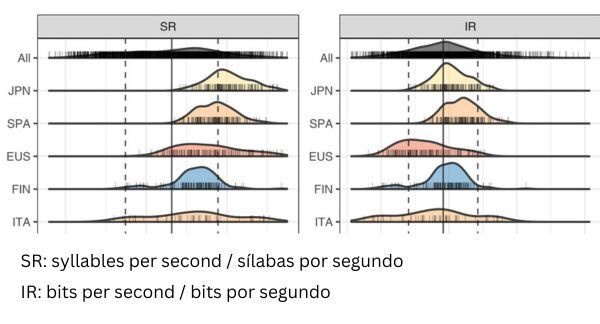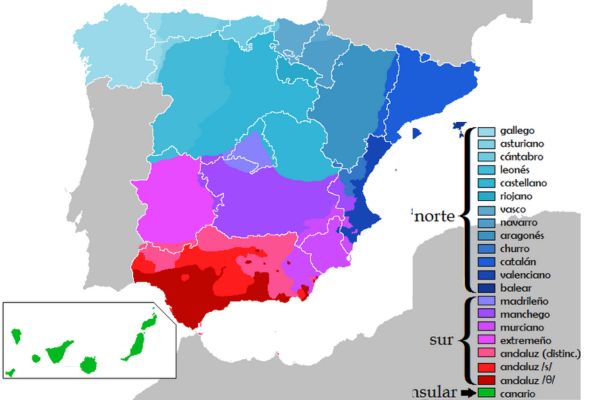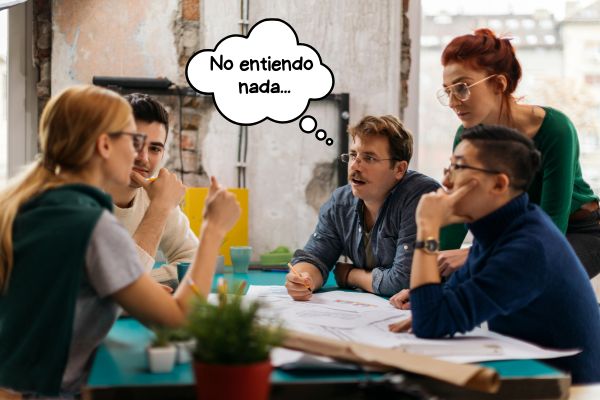How to understand fast Spanish speakers is one of the biggest challenges you will face when you are learning Spanish.
There are many situations in which you may end up thinking “I don’t understand anything I’m hearing.” For starters, in class, even with your own Spanish teacher, who can sometimes speak faster without realising it or using words that you haven’t learned yet.
Other examples in which you may feel confused or frustrated by not knowing how to understand fast Spanish speakers may be while watching a series or a movie in the original version, at a meal surrounded by native speakers, at a work meeting or in a video conference with other Spanish-speaking professionals…
And as I mentioned before, not understanding someone when they are speaking in a language that is not your native language can cause a lot of confusion, and also frustration.
Well, here comes the first good news:
You are not the only one who experiences this.
Not understanding 100% of what native speakers are saying when they speak in our second language, or in the language we are learning, happens to all of us who are beginning the exciting journey of learning new languages.
In this article, I’m going to give you some tips that will help you better understand conversational Spanish. But, before starting, have you ever asked yourself… Why is it so difficult to understand Spanish speakers when they speak?

To answer the question of how to understand fast Spanish speakers, you first need to know some peculiarities of Spanish as a language and of the Spanish and Latin people when we speak.
If you think that Spanish speakers speak very fast, it’s because, in reality, we speak very fast.
A scientific study from 2019 compared the speed of 17 different languages, including English, German, French, Japanese, Spanish, Italian… The conclusion of this study was that Spanish is the second language in the world that generates the most syllables per minute, only surpassed by Japanese.

1- Japanese; 2- Spanish; 3- Euskera or basque; 4- Finnish; 5- Italian
So, if your native language is English, German or French, you will feel that Spanish speakers speak very fast.
But here comes an interesting fact: Spanish is not an efficient language.
This means that Spanish speakers use more words than English, for example, to say the same thing.
Maybe that’s why we have to speak faster.
Spanish is the official language in 21 countries around the world. This has the first direct consequence of creating a wide variety of accents, variants and dialects. Not only between different countries: Mexico, Argentina, Spain… But also within the same country, where we can find different regionalisms.
Look at the example of Spain on this map, where you can see the differences between the different regions of Spain:

Source: Wikipedia
Note: the map only shows the varieties of Spanish, not the other languages spoken in Spain.
The differences between the Spanish of the various Spanish-speaking countries are not only differences in accent and pronunciation (ceceo, seseo, yeísmo…). There are also differences in:
The third reason why you sometimes start to figure out how to understand fast Spanish speakers is that, when we speak, we join sounds and/or syllables or we directly omit them (don’t say them).

Sometimes we don’t understand what the local people of a place tell us, because we don’t have knowledge of the cultural context.
For example, my sister, who lived for a few months in a town in central Spain called Tomelloso (province of Ciudad Real), told me this joke:
I thought it was a really funny joke, because I know that a lot of people in Tomelloso are farmers and make a living off the land.
The word ‘nave’ in Spanish has two meanings:
And of course, to understand this joke, you need to know the cultural context of this specific region of Spain.
Cultural context and cultural references include celebrities from the country, popular TV shows from the country that many people watch, product brands that are characterised by something in particular in that country…
Por ejemplo, si en España en un bar escuchas a alguien decir:
This means that the person is ordering a beer and directly says the brand of the beer, because ‘Mahou’ is one of the most popular beer brands in the country.

When you want to master how to understand fast Spanish speakers, the first thing you need to do, in case you are in the middle of a conversation with a Spanish speaker, and you feel confused and frustrated because you cannot understand that person, is to relax and take a deep breath.
Try to grasp the general idea of the conversation and then, don’t be afraid or embarrassed to ask that person to repeat the information to you, but this time more slowly.
Now, the key to understanding native speakers when they speak Spanish regularly is to improve your listening comprehension.
You can do this in two ways (both necessary):
Passive listening occurs when you are not paying attention to every word that is said in the conversation in Spanish.
Examples of passive listening (even in your own language) would be: when you listen to the radio, when you watch a movie or TV series, when you listen to a podcast, when you listen to an audiobook…
In this case, your attention and concentration are not on understanding each and every word and the most precise details of the conversation, but rather your concentration is on capturing general ideas and messages.
You can practice passive listening for hours. For example, when you watch a movie in Spanish that lasts two hours or when you watch several episodes in a row of a Spanish series that you love.
Active listening, on the other hand, occurs when you are focused and paying attention to each and every word in Spanish, as well as to the details of the conversation.
Examples of active listening are the activities you do in class with your teacher or at home by yourself. If you have ever prepared for official Spanish exams (DELE or SIELE), these exam activities are very good examples of active listening.
Basically, the process is to listen to a short audio of a few minutes two or three times and then answer a series of questions, where you will show whether you have understood the vocabulary, expressions, grammar and details of the conversation well.
Since you need a fairly high level of concentration, you can practice active listening just for a few minutes.

To finish this article on how to understand fast Spanish speakers, here are two magic phrases that you can memorise to use with your Spanish-speaking friends or acquaintances:
These days, I am practising listening activities included in the DELE B1 exam in class with one of my students from Scotland. Martha, my student, has a very good level of Spanish. The activities and conversation that we practice in our General Spanish Classes are at B2 level (intermediate – advanced). But listening comprehension has always been her weak point. I knew that it was something that she was avoiding in class.
Until one day I told her: we have to practice on your listening.
The first listening classes always started with Martha saying ‘Oh, how scary!’
Then we both laughed, began our class, and little by little we started doing activities, repeating the audio, explaining the words that she didn’t understand… It was like a gym workout with an instructor, but instead of training the muscles of the body… We trained Martha’s ears!
It wasn’t easy, I have to say that I felt very proud to see how Martha tried hard and didn’t give up or lose her motivation. And in the end, of course, her listening comprehension improved a lot.
If you want to have personalised classes too, with an accredited native teacher, working with you to learn and improve your Spanish, book a trial class with us and… ¡vamos a hablar!
REFERENCES:
Christophe Coupé et al. ,Different languages, similar encoding efficiency: Comparable information rates across the human communicative niche.Sci. Adv.5,eaaw2594(2019).DOI:10.1126/sciadv.aaw2594
